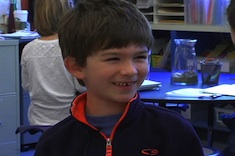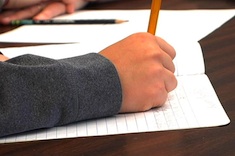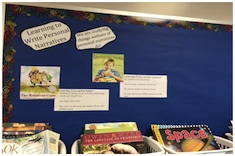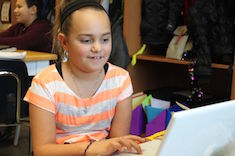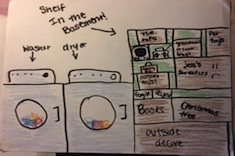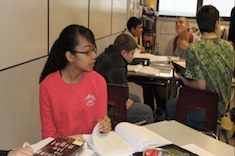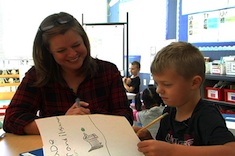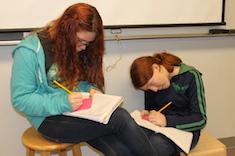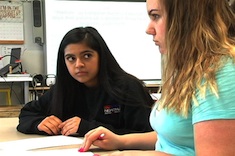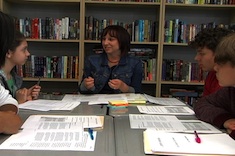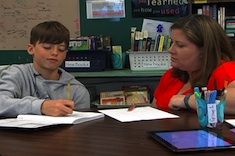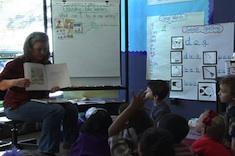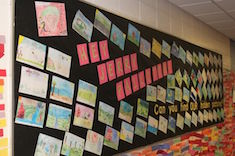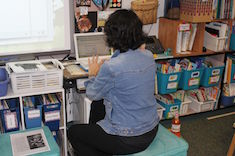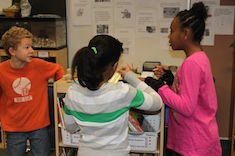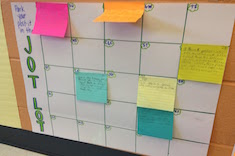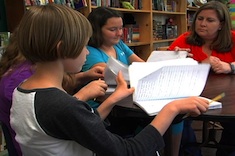Teaching Writing
Everyone who writes for Choice Literacy loves teaching writing, because we all write ourselves. We know it is "hard fun," as Donald Murray famously said—exasperating and exhilarating at the same time. The writing workshops you will read about here and see in our videos are busy, noisy, vibrant places. And most days, we wouldn't want to be anywhere else than in the midst of 'em! Here is where you'll find our latest discoveries, insights, and occasional boneheaded mistakes in teaching writing.
Latest Content
Writing Share Structures
Katrina Edwards moves her first-grade class out of a rut with writing shares by introducing many new options.
Lunchtime Storytelling
Katrina Edwards dreads lunchtime with her first graders, until she makes a conscious effort to build storytelling skills and share experiences more thoughtfully within the group.
Using Stories to Launch Writers’ Notebooks
If you're looking for the perfect launch for writers' notebooks this school year, you might want to begin with story. Tara Barnett and Kate Mills explain how.
Conferring with Spencer: Writing Notebook Topics
Katherine Sokolowski helps fifth grader Spencer brainstorm topics for his writing notebook.
School-to-Home Journals
Are you considering school-to-home journals in your classroom this year? Jennifer Schwanke describes how these notebooks build community and literacy skills.
Is Writing Essential?
Ruth Ayres shares some of the powerful connections between stories and writing workshops.
Planning for a Narrative Writing Unit of Study
Franki Sibberson believes planning a unit of study should be just as much fun as planning a trip to Disney World. She explains her planning process for one of her first units of study, on narrative writing.
Dabbling: Reviving a Focus on Play
Mary Lee Hahn finds a focus on play and "dabbling" renews student writers during a unit on narrative nonfiction.
Humor Writing with Teens
Gretchen Schroeder develops a unit on humor writing that engages and delights her high school students.
My Five Objectives for the Start of the School Year
Gretchen Schroeder winnows many competing demands at the start of the year down to five clear objectives in her high school classroom.
Celebrating and Nudging: First-Grade Writing Conference
Bitsy Parks takes time to celebrate first grader Colson’s finished writing, even as she nudges him to try a technique shared in the day’s minilesson.
Joy
Katrina Edwards deals with a frustrated writer on the verge of tears in her first-grade classroom. She realizes the element that is missing in her writing workshop is joy.
Digital Revision: Conferring with Aidan
In this week’s video, Gigi McAllister helps fourth grader Aidan revise his writing on the computer to flesh out character development.
Creating an On-Demand Writing Checklist
On-demand writing can be a stressful assessment task for students, but it does mimic the type of writing many adults face in their professional lives. Tara Barnett and Kate Mills work with students to create an on-demand writing checklist.
Expert Students
Christy Rush-Levine uses a quick assessment during writing workshop conferences to connect expert students with peers who might need assistance. She includes a video example of the practice.
Literary Analysis: Tone and Scholarly Writing
Christy Rush-Levine shares how to help student writers understand and develop a scholarly tone. The feature includes a video example of small-group instruction.
Brainstorming Writing Topics with Drew
Katherine Sokolowski confers with Drew about writing at home, brainstorming possible topics. In the process she shows how much she knows about Drew's life outside of school.
Using If I Stay to Model Literary Analysis
Christy Rush-Levine uses the mentor text If I Stay to model literary analysis, building on her middle school students’ interest in the recent movie.
Building Relationships with Authors
Katie DiCesare is helping her students move from mentor texts to seeing authors as mentors through their websites and other digital resources.
First-Grade Minilesson: Reading Like Writers
Bitsy Parks teaches her first graders early in the year how to read like writers, highlighting examples from favorite mentor texts.
Hosting Reading and Writing Events
Gigi McAllister explains why you have to be a bit choosy about reading and writing events since there are so many possibilities. Here are some she values in her fourth-grade classroom.
The Riskiest Writing
Mary Lee Hahn tackles the riskiest writing of all — in front of students and improvised with no advance drafting or planning.
Minilesson: Writing a Mentor Text
In this week’s video, Gigi McAllister models writing in front of her fourth-grade class. She takes advice from students as she develops the characters in her story.
Get in the Pool: Teachers Who Write
Ruth Ayres shares how she was always someone who wrote—until she became a teacher. Getting back into writing was all about motivating her reluctant students.
Teachers Who Write
Melanie Meehan explains why your own writing, however imperfect it is, might enhance your teaching tremendously.
Literacy Routines for Applying See-Think-Wonder
Shari Frost finds that the See-Think-Wonder activity is great to use as a “bell-ringer,” as well as throughout the day to promote deeper thinking and engagement.
Teaching Students to Start at the Right Place
Melanie Meehan uses focus questions for teaching students to start at the right place in their writing, moving them beyond the bed-to-bed stories that plague so many literacy workshops.
The Ins and Outs of Using a Jot Lot
Tara Barnett and Kate Mills use a jot lot to turn students’ notes on their learning into instructional plans and assessment.
Environmental Group Notes
Katherine Sokolowski meets briefly with a group of fifth-grade girls to go through the notes they are taking for their environmental studies project and talk through next steps.
Do I Really Have to Keep Conferring Notes?
Ruth Ayres answers a question from teachers, Do I really have to keep conferring notes? Spoiler alert: The answer is yes.
Browse Content By
Type
Category
- Assessment Tools
- Big Fresh Archives
- Booklists
- Choice Numeracy
- Classroom Design
- Common Core
- Community Building
- Conferring
- Content Literacy
- Digital Literacy
- English Language Learners
- Equity
- Family Relations
- Free Samples
- Guiding Groups
- Leadership
- Literacy Coaches
- Mentor Texts
- Minilessons
- New Teacher Mentors
- Podcasts
- Poetry
- Quote Collections
- Reading Strategies
- Self Care
- Struggling and Striving Learners
- Talking and Listening
- Teacher Study Groups
- Teaching Reading
- Teaching Writing
- Word Study and Vocabulary
Author
- Melissa Quimby
- Nawal Qarooni
- Gwen Blumberg
- Julie Cox
- The Lead Learners
- Hannah Tills
- Josie Stewart
- Ruth Metcalfe
- Mallory Messenger
- Becca Burk
- Jodie Bailey
- Vivian Chen
- Mary Brower
- Tiffany Abbott Fuller
- Stephanie Affinito
- Ruth Ayres
- Leigh Anne Eck
- Heather Fisher
- Shari Frost
- Julie Johnson
- Suzy Kaback
- Gigi McAllister
- Shirl McPhillips
- Melanie Meehan
- Cathy Mere
- Debbie Miller
- Tara Barnett and Kate Mills
- Tammy Mulligan
- Dana Murphy
- Bitsy Parks
- David Pittman
- Brenda Power
- Heather Rader
- Matt Renwick
- Mandy Robek
- Christy Rush-Levine
- Gretchen Schroeder
- Jen Schwanke
- Brian Sepe
- Katherine Sokolowski
- Stella Villalba
- Jennifer Vincent
Grade Level
Choice Literacy Membership
Articles
Get full access to all Choice Literacy article content
Videos
Get full access to all Choice Literacy video content
Courses
Access Choice Literacy course curriculum and training


